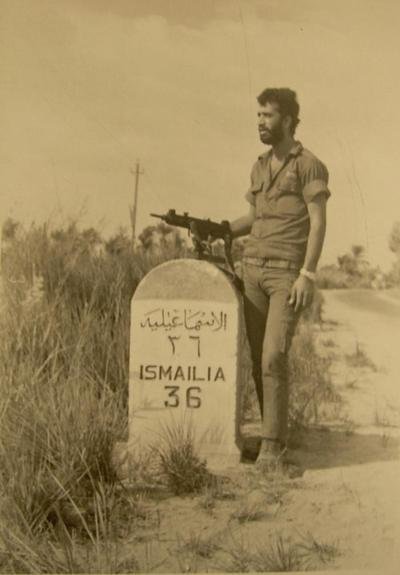History of the Uzi
Yishuv Firearm Production
After World War I, Palestinian and Transjordan territories fell under the British Mandate (the British administration of those areas). The Yishuv (the body of Jewish residents prior to the State of Israel), knowing they would need to defend themselves in the future, began the production of firearms and munitions. Creating underground, clandestine factories, they hid their activities from the British military and armed themselves well before the end of the Mandate. They had the ability to produce ammunition, grenades, mortars, and Sten Guns—simple, low-cost production British submachine guns used by Commonwealth forces through the Korean War. One of their factories produced over 2 million cartridges between 1945 and 1948.
When the Mandate came to an end in 1948 and the State of Israel was formed (known as Nakba Day by the Palestinians), the first Arab-Israeli War broke out. The Haganah (which later became the Israeli Defense Forces also known as the IDF) defended their newly founded country against the surrounding Arab nations.
Despite the UN’s arms embargo in 1948, many additional arms were brought to Israel. A variety of weapons, including fighter planes, were smuggled in by Israeli agents, U.S. aviators, the French, and most famously, from Czechoslovakia.
The Birth of the Uzi
After the war, the underground factories were centralized and became Israel Military Industries (IMI). As a newly founded country, Israel’s military needed a more reliable source of weapons. They turned inward to find a solution to their arms needs, and the IMI and the IDF began working together to create weapons for the military.
An Israeli soldier on the road to Ismailiya with an Uzi during the Yom Kippur War
By נאור עמר - נאור עמר, CC BY 2.5, https://commons.wikimedia.org/w/index.php?curid=8987052
What resulted was the Uzi, a blowback operated, open bolt submachine gun capable of firing 600 rounds per minute. Designed by Major Uziel Gal, this gun is constructed from stamped sheet metal making it easy to manufacture and cheap to produce.
The Uzi’s design was inspired by the Czech CZ Model 25—a submachine gun in production from 1948 to 1968 with a telescoping bolt and magazine well in the pistol grip. Because Czechoslovakia was a key factor in smuggling arms to Israel during the 1948 Arab-Israeli War, it’s no surprise that the inspiration for the Uzi came from a Czechoslovak gun.
The first Uzi prototype was finished just two years after the 1948 war and was adopted in 1951. It was issued to Israeli special forces in 1954, and by 1956, the Uzi was the military’s standard submachine gun used by both front line and rear-echelon troops.
The Uzi in Action
Secret Service with Uzi just after the assassination attempt on President Ronald Reagan in 1981
By Michael Evans - Ronald Reagan Presidential Library - The Assassination Attempt (Direct link), Public Domain, https://commons.wikimedia.org/w/index.php?curid=586198
With the Middle East’s persistent volatility, the Uzi saw action in multiple conflicts. It was used by Israeli forces during the 1956 Suez Campaign, the 1967 Six-Day War, and the Yom Kippur War also known as the 1973 Arab-Israeli War or the Ramadan War. The Uzi’s compact size was perfect for clearing streets, alleys, houses, and buildings during those wars early in Israel’s history.
As one of the most popular submachine guns of all time, the Uzi has been exported to over ninety counties and been manufactured by a variety of companies. For example, the Royal Netherlands Army issued Uzis in 1956, West Germany began using the Uzi in 1959 under the MP2 designation, and the Belgian military, from 1958 to 1971, used Uzis licensed and produced by FN.
Uzi Imports
In the 1970s, the original architect of the Uzi worked for a U.S. company called Action Manufacturing. While living in the U.S., he designed the Uzi carbine, the semi-automatic version of his Uzi.
These semi-autos were produced by the original Uzi manufacturer Israel Military Industries (IMI) and were imported by Action Arms (a subsidiary of Action Manufacturing) beginning in 1980. In all, Action Arms imported 80,000 semi-automatic Uzis. Half were designated Model A and the other half Model B.
The Decline of the Uzi
The Uzi was also popular with various law enforcement groups throughout the world. In fact, more Uzis were sold to both military and law enforcement than any other submachine gun. The Uzi’s most infamous appearance was with the U.S. Secret Service during the attempted assassination of President Ronald Regan in 1981.
But, as the AK grew in popularity throughout the Middle East in the 1980s, the Uzi began to be phased out in favor of the higher powered M16s and the Tavor. Other submachine guns and new PDWs replaced the Uzi. Israel opted for the Micro Tavor and the U.S. chose the MP5 and P90.
While the Uzi is no longer found in many modern military or law enforcement arsenals, it has definitely claimed its place as an iconic firearm.



